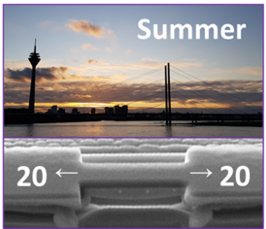Reliable extraction of deformation activation parameters from transient and high strain rate micromechanical tests
In-situ Nano-/Micromechanics Summer Seminar Series 2020
- Date: Sep 10, 2020
- Time: 04:00 PM c.t. - 05:00 PM (Local Time Germany)
- Speaker: Dr. Gaurav Mohanty
- Assistant Professor, Engineering Materials Science, Tampere University, Finland
- Location: Max-Planck-Institut für Eisenforschung GmbH
- Room: Virtual Lecture
- Host: Dr. James Best

Deformation activation parameters like activation volumes, energies and rate exponents are typicallyconsidered as signatures of the underlying deformation mechanism(s) in materials. With advances inmicromechanical tests, there is a rapidly growing body of literature reporting these parameters extractedfrom small length scales. However, the big question that often arises is: how reliable are the extracteddeformation parameters determined from these micromechanical tests? In cases where the activationparameters deviate significantly from standard/expected values, does it imply that the rate controllingdeformation mechanism(s) have changed at smaller length scales? Or are the results misleading, most likelydue to artefacts of measurements and/or incorrect testing methodology and data analysis? This talk willaddress this critical issue by presenting case studies on single and nano-crystalline metals using bothtransient and high strain rate micromechanical tests.To address the issue of reliability of extracted deformation parameters, systematic micropillar compressionand, more conventional, tensile tests will be demonstrated on nanocrystalline nickel. The rationale forchoosing a nanocrystalline metal was that a micro-compression test on a large sized pillar (~ 5-10µmdiameter) still interrogates more than a million grains and the results are not affected by size effects.Therefore, the deformation activation parameters obtained from micro-compression can be compareddirectly with bulk tests. Three types of micro-compression transient tests – strain rate jump, stress relaxationand creep tests - were developed and validated for accurate extraction of deformation parameters. These testmethods will be discussed in details. The extracted exponents and activation parameters (activation volumeand activation energies) from transient tests provide an initial estimate of the rate controlling deformationmechanism(s) which provide insights into the role of dislocation plasticity and grain boundary mediatedprocesses in nanocrystalline metals. In addition, high strain rate testing using both micropillar compression(up to ~ 1000/s) and indentation (up to 10,000/s) will be demonstrated on single crystals and the deformationmechanisms will be discussed based on the extracted activation parameters at very high strain rates. It ishoped that this study will pave the way for routine transient and high strain rate micromechanical testing forexploring deformation mechanisms as a function of structure, strain rates and temperatures in variousmaterial systems.